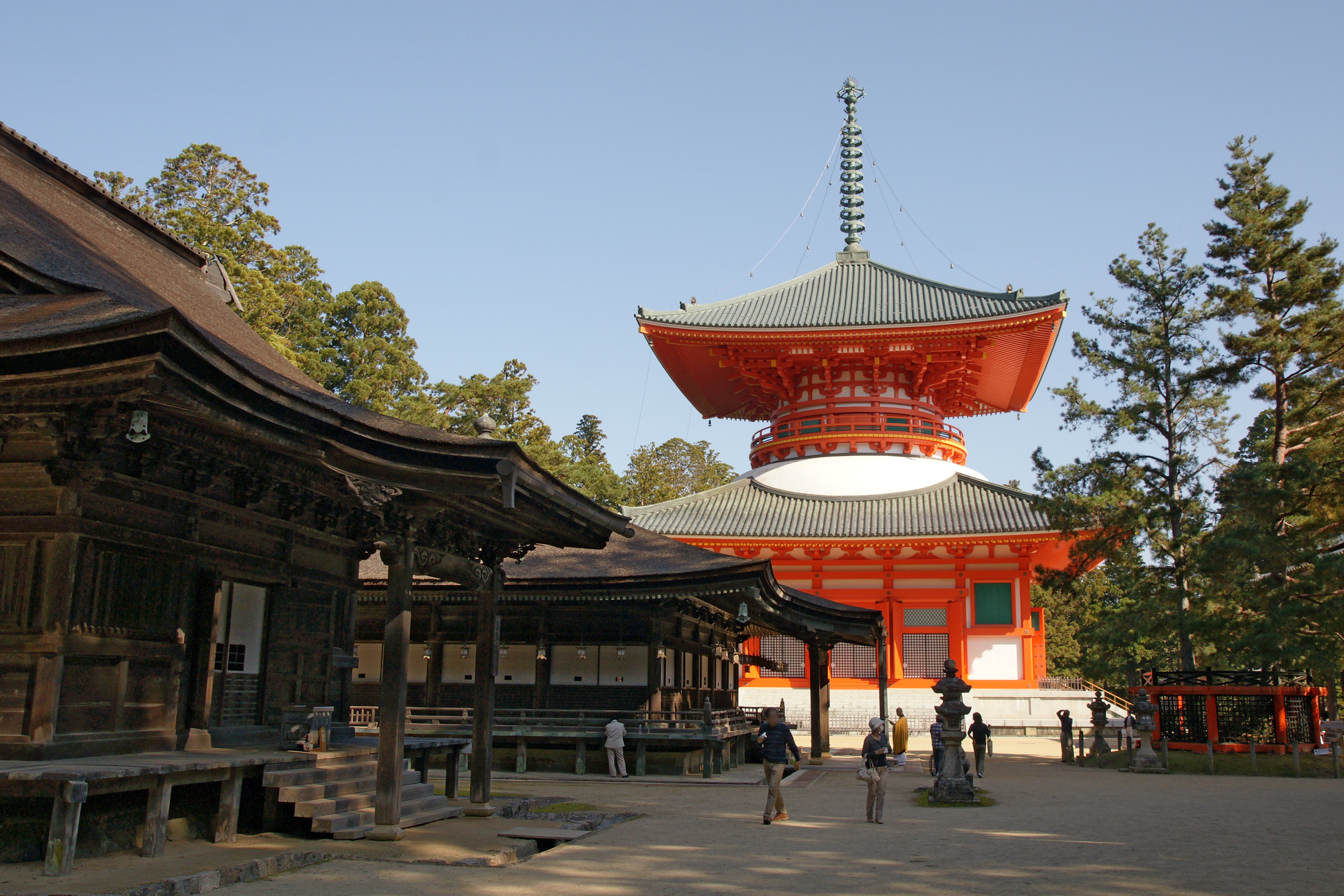
Shingon Buddhism
Shingon (真言宗, Shingon-shū, "True Word / Mantra School") is one of the major schools of Buddhism in Japan and one of the few surviving Vajrayana lineages in East Asian Buddhism. It is sometimes also called Japanese Esoteric Buddhism, or Eastern Esotericism (Dōngmì, 東密). The word shingon is the Japanese reading of the Chinese word 真言 (zhēnyán),[1] which is the translation of the Sanskrit word mantra.
The Zhēnyán lineage was founded in China (c. 7th–8th centuries) by Indian vajrācāryas (esoteric masters) like Śubhakarasiṃha, Vajrabodhi and Amoghavajra. These esoteric teachings would later flourish in Japan under the auspices of a Buddhist monk named Kūkai (空海, 774–835), who traveled to Tang China and received these esoteric transmissions from a Chinese master named Huiguo (746–805). Kūkai established his tradition at Mount Kōya (in Wakayama Prefecture), which remains the central pilgrimage center of Shingon Buddhism.
The practice of the Shingon school stresses that one is able to attain "buddhahood in this very body" (sokushin jōbutsu) through its practices, especially those which make use of the "three mysteries" (Jp: sanmi 三密) of mudra, mantra and mandala.[2][3] Another influential doctrine introduced by Shingon was the idea that all beings are originally enlightened, a doctrine that was known as hongaku.[4]
The Shingon school's teachings and rituals had an influence on other Japanese traditions, especially those of the Tendai school, as well as Shugendo and Shinto.[5] Its teachings also influenced the ritual repertoire of Japanese Zen, including Soto Zen (through the figure of Keizan).[6] Shingon Buddhism also influenced broader Japanese culture, including medieval Japanese aesthetics, art, and craftsmanship.[7]
Doctrines[edit]
Sources[edit]
The teachings of Shingon are based on Mahayana texts, and early Buddhist tantras. The key esoteric sources are the Mahāvairocana Sūtra (大日経, Dainichi-kyō), the Vajraśekhara Sūtra (金剛頂経, Kongōchō-kyō), and the Susiddhikara Sūtra (蘇悉地経, Soshitsuji-kyō).[54] Important Mahayana sutras in Shingon include the Lotus Sutra, the Brahmajāla Sūtra and Heart Sutra. Kūkai wrote commentaries on all three.[55]
Shingon derives form the early period of Indian Vajrayana (then known as Mantrayana, the Vehicle of Mantras).[56] Unlike Tibetan Buddhism, which focuses on the Anuttarayoga Tantras, which are tantras that arose at a later date of Indian Buddhism, Shingon bases itself on earlier works like the Mahavairocana which generally lack the antinomian uses of sexual yoga, taboo substances and charnel ground imagery found in the later tantras.[57] Nevertheless, the concept of "great bliss" (tairaku) and the transformation of desire (and other defilements) into wisdom is found in Shingon.[57]
Another important sutra in Shingon is the Prajñāpāramitānaya-sūtra (Jp. Hannyarishukyō, Taishō vol. 8, no. 243). This is a late "tantric" Prajñaparamita sutra in 150 lines which was translated by Amoghavajra and which contains various verses and seed syllables which encapsulate the Prajñaparamita teaching.[58][59] The Hannyarishukyō is used extensively in Shingon as part of daily recitation and ritual practice.[59] The full Sanskrit title is Mahāsukhavajra-amoghasamaya-sūtra (Ch. Dale jingang bukong zhenshi sanmohe jing, Sutra of the Vow of Fulfilling the Great Perpetual Enjoyment and Benefiting All Sentient Beings Without Exception).[60]
Another important source for the Shingon school is the Awakening of Faith and a commentary on it called the On the Interpretation of Mahāyāna (Shi Moheyan lun 釈摩訶衍論, Japanese: Shakumakaen-ron, Taisho no. 1668), which was traditionally attributed to Nagarjuna (though it is likely an East Asian composition).[61][62]
Finally, the works of Kūkai are key sources in Shingon Buddhism, including his various commentaries on the key esoteric texts of Shingon as well as original works like his magnum opus, the ten volume Jūjū shinron (Treatise on Ten Levels of Mind) and the shorter summary Hizō hōyaku (Precious Key to the Secret Treasury).[63]
The Shingon lineage is an ancient transmission of esoteric Buddhist doctrine that began in India and then spread to China and Japan. Shingon or Orthodox Esoteric Buddhism maintains that the expounder of the doctrine was originally the Universal Buddha Vairocana, but the first human to receive the doctrine was Nagarjuna in India. Like all major East Asian Buddhist tradition, the Shingon tradition developed a list of "patriarchs" which were considered to be the key figures in the transmission of their lineage. Shingon recognizes two groups of eight great patriarchs – one group of lineage holders and one group of great expounders of the doctrine.